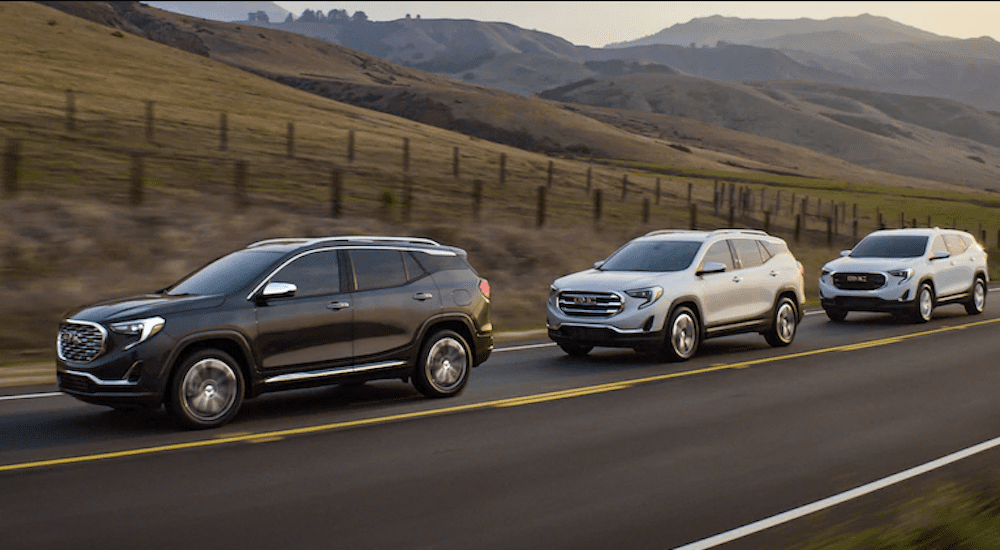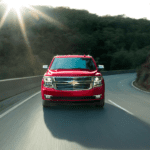A friend and coworker recently found themselves in the market for a new vehicle, courtesy of the lifestyle change one experiences when they find out they’re about to become a first-time parent. Now, it’s worth clarifying that we’re not here to talk about all the changes to come (that for another article, on an entirely different site). However, I was asked to weigh in on some of the vehicles they were considering, with the aim of whittling down the short-list. Atop that list? The 2019 GMC Terrain vs 2019 Honda CR-V.
In all fairness, my input would come with a bit of a bias..my well-publicized disdain for crossovers. But a friend in need is a friend indeed, so it was time to set aside my automotive prejudice, work out some of the pros and cons and assist them in finding the right vehicle for them. And it would appear, my new friend, that you are now along for the ride (be sure to keep your arms and legs inside the ride at all times).
The Basics
Kicking things off, it’s important to stress that both the Terrain and the CR-V as accessible vehicles. By this, I mean that neither are priced outrageously or are ranked among the kind of aspirational offerings that come with heirs and graces. They’re great entry-level vehicles, in their own right.
The Terrain, for example, is the gateway to GMC’s SUV lineup. Priced to start around $25,000 MSRP the Terrain is served up in a total of six trim levels (SL, SLE, SLT, SLE Diesel, SLT Diesel and the line-topping Denali) and – as you can see – these include diesel variants. We’ll cover the powertrains in greater detail below, but the diversity of offerings available within a (roughly) $20G window are commendable. In addition, GMC has always aspired to deliver products conceived with a luxury sensibility.
The CR-V on the other hand is slightly higher up Honda’s food chain, being a step above the more accessible HR-V. Priced to start around $24,350 MSRP the CR-V comes in your choice of four trim levels (LX, EX, EX-L and Touring). While configuration plays an obvious role, the price range between trim levels feels a little more conservative than seen with the Terrain, falling closer to the $10G point.
So, all things being equal, the Terrain and CR-V measure up nicely against one another, falling within the right price range while offering up a healthy number of options for customization. Both are front-wheel drive standard with the (too sensible not-to-embrace) option of all-wheel drive making them ideal for New England seasonality and diversity of terrain. So, in the comparison of these five-seaters, let’s call it a dead heat at this point (1:1).
Performance Ratings
Depending on trim and configuration, the Terrain comes equipped with one of three powertrains. First, a 1.5-liter turbocharged 4-cylinder paired to a 9-speed automatic transmission delivers 170 hp and 203 lb-ft of torque. A 2.0-liter variant serves up 252 hp and 260 lb-ft of torque. While the 1.6-liter turbodiesel, cranks out a confident 137 hp and 240 lb-ft of torque.
At the base trim level, the CR-V comes powered by a naturally aspirated 2.4-liter 4-cylinder paired with a continuously variable transmission, resulting in 184 hp and 180 lb-ft of torque. There is also the option of a 1.5-liter turbocharged 4-cylinder that delivers 190 hp and 179 lb-ft of torque.
While Honda’s configuration and ratings are confident in their own right, it would be hard to argue that GMC delivers more performance and diversity. Be it gas or diesel, there’s no shortage of options to choose from. (2:1 GMC)
Exterior Design
Of course, any discussion of design or aesthetic is subjective in nature. What catches one person’s eye might turn another off at first glance. Full disclosure, it factors into my lack of enthusiasm for SUVs in general since I consider most of their exterior designs to feel somewhat uninspired.
But this comparison provides a great example of the two primary styles visible in today’s SUV market. First, we have the traditional truck-inspired aesthetic born of the classic unibody SUV style. This is, of course, evident in the Terrain which evolves that design philosophy into a smoother, contoured version more relevant in today’s design language. The octagonal grille is blacked-out to create a more open feel, which helps to emphasize the badging. And just as the ridged hood design builds backwards from its front fascia, the sheared headlamp design pulls up-and-outward accentuated further by the sleek contouring of the Terrain’s body panels. And a reverse-shearing of the taillights help to pull the rear fascia of the Terrain back together, making it a fully-realized aesthetic that I find surprisingly appealing.
On the other hand, the CR-V embodies the modern crossover vibe, meaning a less truck-like feel overall. And while I normally find this more difficult to redeem, Honda has made an admirable attempt to create a sense of streamlined refinement in the CR-V. That said, where the Terrain feels purposeful, the CR-V continues to feel less impactful. In my mind, there’s really nothing wrong with it – but then again, there’s really nothing that jumps out as if to scream, “Honda got it right!”
Thus, another win for the Terrain (3:1 GMC)
(Although it is worth noting that Honda has some vibrant, fresh color options like ‘Molten Lava’, ‘Obsidian Blue’ and ‘Basque Red’)
Interior Design
Almost a continuation of the same conversation, discussion of each interior (at least aesthetically) is subjective, and both interiors feel consistent with the approach taken in deciding the exterior look.
The Terrain, for example, feels expansive and truck-like. Using a horizontal motif, the dash seems to push outward from the center stack, furthering the in-cabin perception of spaciousness. But, to be clear, it’s more than just a perception; the Terrain offers a comfortable cabin experience for both front and rear passengers with ease of both entrance and embarkation. Confident material choices abound across the various trim levels, ascending to a perforated (and even heated) leather-appointed finish.
And here’s where the CR-V surprises me a bit. While other in-class competitors used a fully curved motif (which does the cabin a disservice by ‘hugging it inwards’) the CR-V combines both philosophies, utilizing a wide-stretching slant to create a more open feel for front passengers. And while it may not feel quite as expansive as the Terrain, it’s both comfortable and indicative of an upscale mindset.
Thus, we have to rule this as a bit of a tie, to be decided by your own subjective tastes (4:2 GMC)
Final Thoughts
Sure, there are any number of other factors to be taken into consideration from fuel economy to cargo space, infotainment to utility ratings. Unfortunately for Honda, a quick perusal of each of these headers only serves to emphasize the strengths of the Terrain.
With that in mind, I made my recommendation to my friend, and I’ll make the same one to you. If considering the 2019 GMC Terrain vs 2019 Honda CR-V, and you appreciate the value of an upsized SUV, it’s easy to throw your support behind the Terrain. Of course, some of you might prefer the more modest footprint of the CR-V and that’s fine too.





